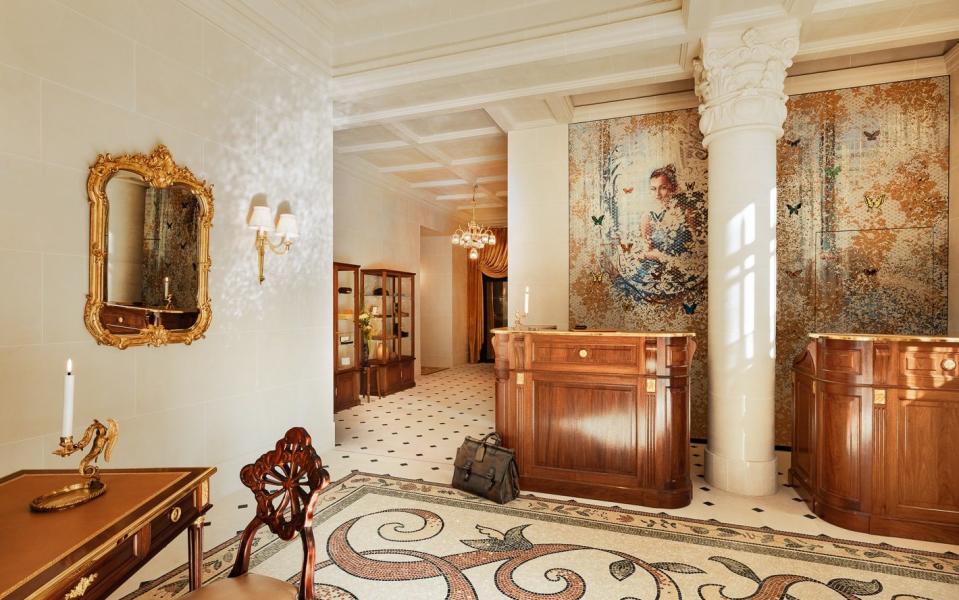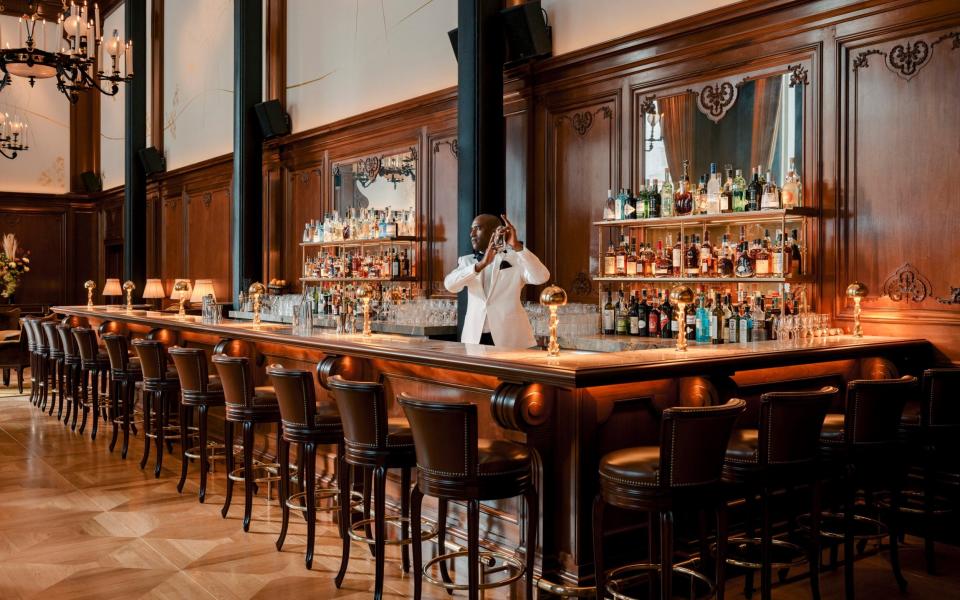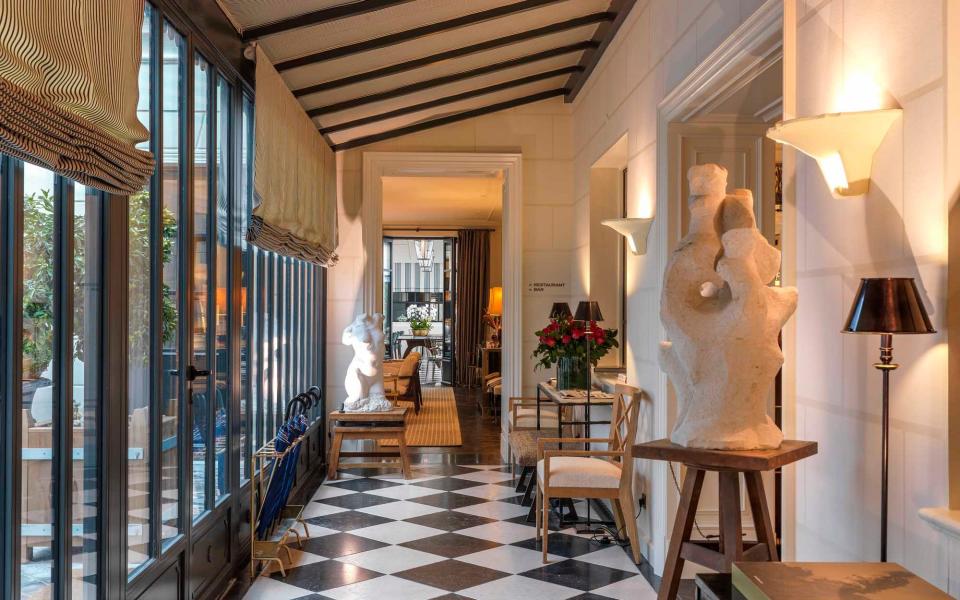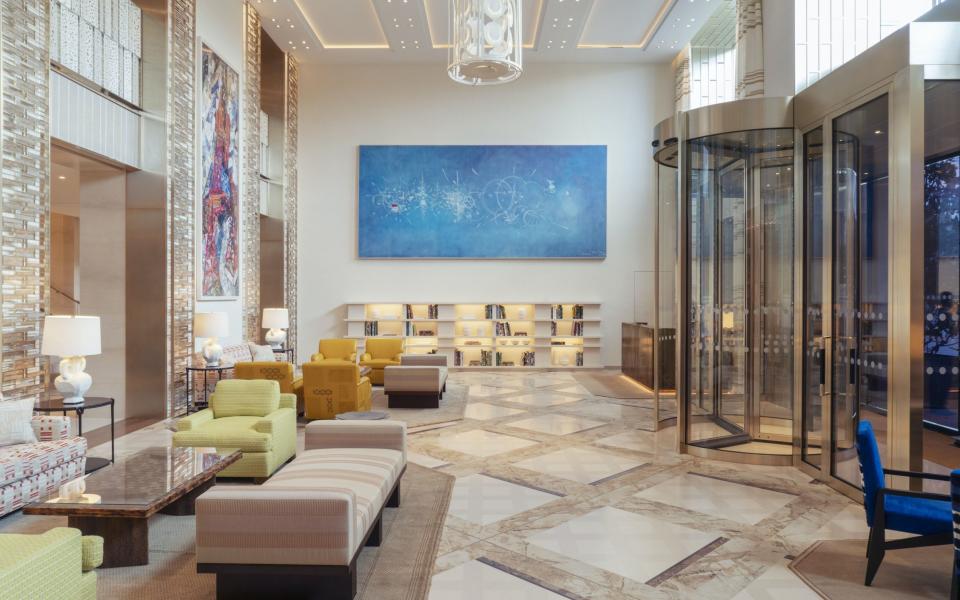The Paris hotel revolution has arrived – here's where to stay

Among the loveliest of the many lovely things I saw in Paris when I was there a fortnight ago were two spectacularly graffitied walls. One of them bore the words: “Paris is still this monstrous wonder, astonishing assemblage of movements, machines and thoughts, the city of a hundred thousand novels, the head of the world.”
The quote was from Honoré de Balzac (though he cannot be blamed for the translation, which is my own). The graffitist was the irrepressible multimedia artist Jacques Villeglé, now well into his nineties. And the walls were those of Madame Rêve, one of half a dozen superb new Paris hotels in which it was my professional duty to loll about over the course of a particularly enjoyable week.
Balzac’s observation struck just the right note. In terms of fancy new hotels, Paris is abuzz. If you thought the city had reached saturation point in the years preceding the pandemic, think again. In Paris, it seems, there is never quite enough room in the inn, and always room for more inns. What this latest crop has in common is not a similar style or price point – on the contrary, they vary enormously, from streamlined modernism to full-on Second Empire velvet and taffeta freak-out, and from 200 euros a night to 5,900. What they do have in common, though, is a certain tone – warmth without over-familiarity, indulgence without servility – that has not, perhaps, always or often been associated with Parisian hotels of any kind, let alone notably nice ones such as these.

Madame Rêve occupies about a third of the vast central post-office building on the Rue du Louvre. Most Parisians over a certain age will have a story to tell you about this place. Until it closed for renovation a decade ago it was the only post office in the country that remained open day and night, and therefore the only one where time-sensitive correspondence could be officially date-stamped around the clock. If there was ever a romantic way to file a tax return, this was it: a minute or two before the clock struck midnight on the last day of the financial year in a cathedral-like 24-hour post office around the corner from the Louvre.
The curious layout of the hotel is part of its appeal. The ground floor is mostly given over to a stupendous café, in what used to be a dispatch centre and loading bay, with ceilings eight metres high, fin de siècle styling and a delicious, caramelly, golden-brown glow. All the rooms are on the third floor. Those facing the inner courtyard have, for Paris, quite startling views of steel and glass, and terraces thickly planted with climbing plants – the contemporary urban jungle. Those facing out have views of an entirely familiar yet equally startling kind – the city itself, in all its Haussmannian magnificence.
The hotel had just opened at the time of my visit and, though the café was going gangbusters, its other restaurant, La Plume, under the eaves on the fourth floor, was only serving breakfast. There can be little doubt that it will be swamped when it is fully operational. The hotel’s owner, Laurent Taïeb, is best known for Kong, another dramatic top-storey beanery; and the executive chef, Benjamin Six, is something of a phenomenon, a computer programmer who had a change of heart, opened a bar, taught himself to cook and went on to become a star at Zuma. Expect Franco-Japanese fireworks at La Plume to match the dazzling panorama of St-Eustache and Les Halles. If you are impressed by how marvellous the church looks at night, newly illuminated, you have Taïeb to thank for that too. He paid for the lights; a stroke of genius.

Altogether Madame Rêve is a powerfully attractive proposition. It is not complicated – rooms, restaurants, rooftop – but what it does, it does remarkably well. The general manager, Frédéric Le Gallois, summed it up well when he told me: “It’s an evolution, not a revolution.”
That tidy quip got me thinking. The evolution of the modern hotel has comprised three revolutions: the invention of the grand hotel in the early 19th century, the rise of the industrial or chain hotel in the mid-20th century and the arrival of the boutique hotel – small, metropolitan, with a pronounced emphasis on a coherent visual identity – in… well. Usually people say 1984, when Ian Schrager and Steve Rubell opened Morgans in New York, with interiors by Andrée Putnam, or 1988, when they opened the Royalton, also in New York, with interiors by Philippe Starck. But another entirely plausible claimant to the thoughtfully designed, bijou-proportioned throne is Blakes, which opened in London in 1978, with interiors by Anouska Hempel.

Another boutique hotel with interiors by Anouska Hempel has lately opened in Paris. Monsieur George, on the Rue Washington, off the Champs-Élysées, is proof of the enduring charm and versatility of the Blakes template, with its bohemian clutter, strokable fabrics, low lighting, foxed mirrors and aura of well-mannered elegance about to spill over into outright loucheness.
The top-floor suite deserves special mention. Admirers of the Hempel style will want to see it to believe it: a white-on-white affair, innocent as a nursery, as a puff of Gitanes smoke on a cloudy day used to be. And from the loo you can see the Louis Vuitton flagship store – the interiors of which Anouska Hempel did too.
Her boutiquey heirs are everywhere – among them the Hôtel Costes, now with its brand-new Castiglione annexe in what was previously the Lotti, and the latest Soho House, in the hôtel particulier where Jean Cocteau grew up. On the rive gauche, at the elegant end of the Rue de Lille, JK Place Paris combines with impeccable flair flea-market finds, Hermès lamps, shot-silk curtains, boiserie panels and original drawings by Cristóbal Balenciaga. With JK Place we may have reached the outer limits of boutique territory – things are getting pretty ritzy.

The two most impatiently awaited of the big Paris openings were undoubtedly Cheval Blanc and the Bulgari – and at the time of writing the opening of the Bulgari is still impatiently awaited. With these two, however, we are no longer in boutique-hotel territory at all. We are somewhere else – back in the realms of the old-fashioned grand hotel, or near as dammit, only with more up-to-date design codes. I expect official “palace” designation will follow in due course for both of them.
My expectations for Cheval Blanc were very high, based on what I already knew of the other LVMH-owned Cheval Blanc properties, in the Maldives, Courchevel, St Barths and St Tropez. Whatever you might have heard about the Paris hotel – its situation within the Samaritaine building; its pale, airy, richly textured, impeccably choreographed yet somehow effortless opulence; its epic Dior Spa; its seven-bedroom, two-storey penthouse, L’Appartement, complete with Sonia Delaunay lithographs and sculptural bannisters by the late Claude Lalanne – it is all true. And then some.
The really nifty trick they have performed here is to create, by dint of years of strenuous effort, joined-up thinking and a practically unlimited budget, a convincing illusion of effortlessness and ease, a 21st-century version, in bricks and mortar, of Charles Baudelaire’s luxe, calme et volupté. Those funny, faintly cellular patterns on the headboards, for example, reminded me of the shapes you see behind your lids when you scrunch your eyes shut against strong sunlight – as if you were floating on your back in some Maldivian lagoon or your pool in St Tropez. Effortless and easy.

The Bulgari, meanwhile, was not yet open, but they let me in anyway. I am glad they did because it blew my mind. I love the other Bulgari city hotels – Shanghai especially – but this one is the pick of the litter. It is the most Roman and the most jewel-like of the great Roman jewellery brand’s hotels, radiant in its details. Almost the first thing I noticed stepping inside off the Avenue George V was the exquisite visual rhyme between a ruby-red ceramic piece by Gio Ponti and an armchair on the other side of the room upholstered in the same shade. At the same time the hotel seems wholly at ease in its Parisian context – you might say in its own skin, which is that of a formerly unremarkable modern building that has been magicked into a state of dewy lusciousness. The Four Seasons Hotel George V eyes up this apparition from across the street. The Bulgari meets its gaze and winks teasingly.
Towards the end of my trip, I took myself off to Le Bristol for lunch with its manager, Leah Marshall. Leah has seen it all and I wanted her thoughts. She agreed that the impetus for a change to a less mannered, more accessible tone in Parisian hospitality is coming from young, non-Michelin-starred chefs, and from hoteliers who are not trying to ape the grand style – nimble, energetic outfits such as the Paris Society and the Experimental Group.

How, I asked, is Paris capable of sustaining so many remarkable new hotel openings, year after year, irrespective of economic downturns, political calamity or global health crises? She put it down to two things. First, the city’s overwhelming popularity as a destination for leisure travellers – it has long been the most visited city in the most visited country in Europe. Second, because it continues both to whet and to satisfy travellers’ insatiable appetite for the new.
By the time we said goodbye the light outside had begun to fade. I set off on foot, unhurried, following no particular route, back towards the river. Leah was surely right about the numbers and the novelty. But as I admired the darkening silhouettes of great buildings and the reflections of lights in the surface of the Seine, I recalled another quote on the graffitied walls at Madame Rêve – one that, it seemed to me at that moment, got a little closer to the heart of the matter, to the why of Paris’s eternal fascination. The quote was from Jean Racine: “We have nights more beautiful than your days.”
How to do it
Madame Reve (madamereve.com) offers doubles from £427; Monsieur George (monsieurgeorge.com) from £274; Cheval Blanc (chevalblanc.com) from £983 and Bulgari (bulgarihotels.com) from £1,069. To read reviews of more Paris hotels, see our guide.

